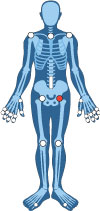In this issue
- What's new in the science of arthritis?
- What does 'building bridges' mean at the CRA?
- It's not "just" osteoarthritis
- Kids & Arthritis
- Working with arthritis
- Targeted specific research
- “Mind” your arthritis
- Hot topics from arthritis patient organizations
- Models of arthritis care
JointHealth™ insight Published April 2019

#CRArthritis2019 – Bringing the latest research and knowledge from the Canadian rheumatology community to people living with arthritis
Arthritis Consumer Experts (ACE) joined together with their patient partners – Canadian Spondylitis Association and the Arthritis Patient Advisory Board of Arthritis Research Canada – to host the fifth annual #CRArthritis Facebook and Twitter Live event at the 2019 Canadian Rheumatology Association (CRA) and the Arthritis Health Professions Association (AHPA) Annual Scientific Meeting. The event was carried live on ACE’s Arthritis Broadcast Network – a multi-media platform for the arthritis community to share news, information and stories about living well with arthritis. Featuring live interviews with leading researchers, patient advocates and healthcare providers in Canada, the event highlights the deep knowledge and skills in the Canadian rheumatology community and the latest research relevant to arthritis patients, their families and even other care providers.
In this issue of JointHealth™ insight, we explore this year’s theme of “building bridges” and present a curated guide to a selection of #CRArthritis interviews. This issue will include research highlights, news from the patient organizations, and helpful lifestyle tips from healthcare providers.

The CRA and AHPA Annual Scientific Meeting provide academics, clinicians and patients a space to discuss new concepts in arthritis diseases and review new treatment guidelines. The theme of this year’s meeting was “Building Bridges”: Bringing together different groups and perspectives to ensure the best care for patients with rheumatic diseases. Where do the bridges lead? To patients, researchers across Canada, physio and occupational therapists, health psychologists among others. When building models of care, the building bridges theme help include the input of diverse patients groups, such as that of the indigenous communities. We hope you will be inspired by the building bridges theme throughout this issue, starting with interview 28 – Ahmad Zbib: The CRA and Building Bridges.
interview 28 – Ahmad Zbib: The CRA and Building Bridges.
It's not "just" osteoarthritis
Kids & Arthritis
Working with arthritis
Targeted specific research
What’s up with arthritis medication?
“Mind” your arthritis
Hot topics from arthritis patient organizations
Models of arthritis care
Listening to you
We hope you find this information of use. Please tell us what you think by writing to us or emailing us at feedback@jointhealth.org. Through your ongoing and active participation, ACE can make its work more relevant to all Canadians living with arthritis.
Update your email or postal address
Please let us know of any changes by contacting ACE at feedback@jointhealth.org. This will ensure that you continue to receive your free email or print copy of JointHealth™ insight.
Arthritis Consumer Experts (ACE)
Who We Are
Arthritis Consumer Experts (ACE) operates as a non-profit and provides free research based education and information to Canadians with arthritis. We help (em)power people living with all forms of arthritis to take control of their disease and to take action in healthcare and research decision making. ACE activities are guided by its members and led by people with arthritis, scientific and medical experts on the ACE Advisory Board. To learn more about ACE, visit www.jointhealth.org
Disclosures
Over the past 12 months, ACE received grants-in-aid from: Arthritis Research Canada, Canadian Biosimilars Forum, Canadian Institutes of Health Research, Canadian Rheumatology Association, Eli Lilly Canada, Hoffman-La Roche Canada Ltd., KT Canada, Merck Canada, Novartis, Pfizer Canada, Sandoz Canada, Sanofi Canada, St. Paul's Hospital (Vancouver), UCB Canada, and the University of British Columbia.
ACE also received unsolicited donations from its community members (people with arthritis) across Canada.
ACE thanks funders for their support to help the nearly 6 million Canadians living with osteoarthritis, rheumatoid arthritis, psoriatic arthritis, ankylosing spondylitis and the many other forms of the disease.
Disclaimer
The material contained on this website is provided for general information only. This website should not be relied on to suggest a course of treatment for a particular individual or as a substitute for consultation with qualified health professionals who are familiar with your individual medical needs. Should you have any healthcare related questions, you should contact your physician. You should never disregard medical advice or delay in seeking it because of something you have read on this or any website.
This site may provide links to other Internet sites only for the convenience of World Wide Web users. ACE is not responsible for the availability or content of these external sites, nor does ACE endorse, warrant or guarantee the products, services or information described or offered at these other Internet sites.
Although the information presented on this website is believed to be accurate at the time it is posted, this website could include inaccuracies, typographical errors or out-of-date information. This website may be changed at any time without prior notice.

#CRArthritis2019 – Bringing the latest research and knowledge from the Canadian rheumatology community to people living with arthritis
Arthritis Consumer Experts (ACE) joined together with their patient partners – Canadian Spondylitis Association and the Arthritis Patient Advisory Board of Arthritis Research Canada – to host the fifth annual #CRArthritis Facebook and Twitter Live event at the 2019 Canadian Rheumatology Association (CRA) and the Arthritis Health Professions Association (AHPA) Annual Scientific Meeting. The event was carried live on ACE’s Arthritis Broadcast Network – a multi-media platform for the arthritis community to share news, information and stories about living well with arthritis. Featuring live interviews with leading researchers, patient advocates and healthcare providers in Canada, the event highlights the deep knowledge and skills in the Canadian rheumatology community and the latest research relevant to arthritis patients, their families and even other care providers.
In this issue of JointHealth™ insight, we explore this year’s theme of “building bridges” and present a curated guide to a selection of #CRArthritis interviews. This issue will include research highlights, news from the patient organizations, and helpful lifestyle tips from healthcare providers.

The CRA and AHPA Annual Scientific Meeting provide academics, clinicians and patients a space to discuss new concepts in arthritis diseases and review new treatment guidelines. The theme of this year’s meeting was “Building Bridges”: Bringing together different groups and perspectives to ensure the best care for patients with rheumatic diseases. Where do the bridges lead? To patients, researchers across Canada, physio and occupational therapists, health psychologists among others. When building models of care, the building bridges theme help include the input of diverse patients groups, such as that of the indigenous communities. We hope you will be inspired by the building bridges theme throughout this issue, starting with
It's not "just" osteoarthritis
 |
Osteoarthritis (OA) is by far the most common type of arthritis. It is estimated to affect more than 3.2 million Canadians – about 1 in 10. In
In |
 |
Weight management, regular physical activity and muscle strengthening exercises will help reduce OA pain and could prevent further joint damage. |
Kids & Arthritis
 |
Approximately 24,000 children in Canada, or every 3 in 1000, have some form of arthritis or pediatric rheumatic disease, the most common being juvenile idiopathic arthritis (JIA). Our guests on the #CRArthritis Facebook and Twitter Live event describe the innovative ways that they are working to improve the lives of children and youth with rheumatic diseases. In
In In To learn more about pediatric rheumatology, watch the following interviews: |
 |
Learn more about JIA? Visit: http://bit.ly/JHJuvenileArthritis |
 |
Johnson added: “What we [physicians] learnt from that project is they [the children] have wealth to teach us, no matter the age, no matter how long they’ve had their disease.” |
Working with arthritis
|
Work can present considerable challenges for people living with arthritis. According to an estimate of the economic burden of illness by Statistics Canada, work disability from arthritis costs $13.6 billion per year. In
Another important dimension of working with arthritis is presenteeism, defined as when a person is physically present at work but has a decrease in work productivity due to sickness or disease symptoms. This impacts the company, the employer and the employee themselves. In |
 |
Click here to learn about Canadian companies who apply the best arthritis strategies and practices in the workplace. |
Targeted specific research
 |
There are more than 100 different types of arthritis, that fall into two major groups: osteoarthritis and inflammatory arthritis. Several interviewees shared with us important advancements targeted at specific types of arthritis..
Scleroderma is a rare autoimmune connective tissue disease in which skin of the extremities, chest, abdomen, and/or face becomes thick and hard. It can cause issues in the blood vessels, scarring of organs, Raynaud’s and gastrointestinal tract complications. In In To learn more about research in disease specific areas, watch the following interviews: |
 |
Click here read about the different forms of arthritis, symptoms and treatment options. |
 |
What we found was that frailty index scores early in disease were predictive of future mortality, as well as other important outcomes like organ damage and hospitalization,” said Legge. |
What’s up with arthritis medication?
 |
In the last 20 years, the big advancement in rheumatology has been the development of biologic drugs; drugs that have powerful influence on inflammatory forms of arthritis. As some of the patents for biologics have started to expire, companies have developed generic forms of the drugs called biosimilars. Evidence has shown that biosimilars are the same as biologics in
safety and efficacy, and since being approved by Health Canada, many doctors are now beginning to prescribe them.
In To learn more about medications in rheumatology, watch |
 |
If you are exploring complementary therapies in addition to your medication, such as cannabis, don’t
be afraid to tell your rheumatologist or nurse. It is important that they know the different pain management strategies you are trying and how they are working for you. |
 |
Looking for more information about arthritis medications? Check out the JointHealth™ Medications Guide. |
“Mind” your arthritis
 |
People living with inflammatory arthritis (IA), such as rheumatoid arthritis (RA), spondyloarthritis, psoriatic arthritis and lupus experience physical and emotional challenges. In
In |
 |
If you are experiencing mental health challenges, do your best to tell your doctor. It is important for them to be aware of these symptoms (like anxiety or depression) so they can provide the proper help or refer you to resources and specialists who can help. This special addition of JointHealth™ insight gives information about arthritis and mental health. |
Hot topics from arthritis patient organizations
 |
Patient organizations play an important role in the rheumatology community. They often act as a bridge between researchers and healthcare providers and patients and their families. Our guests tell us about the arthritis patient-consumer organizations they are involved with and what projects they are working on.
|
 |
To learn about different patient resources in Canada, check out this helpful infographic from the Arthritis Alliance of Canada. |
Models of arthritis care
 |
The Arthritis Alliance of Canada states that a Pan-Canadian Approach to Inflammatory Arthritis (IA) Model of Care establishes a framework for the development of high quality models of IA care that are evidence formed and reinforced by best practices. For a comprehensive model of care, many “team members” should be involved in a patient’s treatment plan (i.e. occupational therapist, physiotherapist, nurse, pharmacist, family doctor, social worker).
“What we are trying to do is build interprofessional team-based care, because really patients need much more than just a drug,” says Dr. Vandana Ahluwaila in |
 |
Learn more about modern models of arthritis care here. |
|
Another important aspect of care is ensuring that treatment plans are meaningful to patients and align with their preferences and values, “because it’s not just a matter of knowing the disease, it’s a matter of knowing the patient as well” says Dr. Beth Hazel in
|
 |
In order to receive the best care, patients should learn strategies for getting the most from their medical appointments. In |
 |
Learn more about modern models of arthritis care here |
Listening to you
We hope you find this information of use. Please tell us what you think by writing to us or emailing us at feedback@jointhealth.org. Through your ongoing and active participation, ACE can make its work more relevant to all Canadians living with arthritis.
Update your email or postal address
Please let us know of any changes by contacting ACE at feedback@jointhealth.org. This will ensure that you continue to receive your free email or print copy of JointHealth™ insight.
Arthritis Consumer Experts (ACE)
Who We Are
Arthritis Consumer Experts (ACE) operates as a non-profit and provides free research based education and information to Canadians with arthritis. We help (em)power people living with all forms of arthritis to take control of their disease and to take action in healthcare and research decision making. ACE activities are guided by its members and led by people with arthritis, scientific and medical experts on the ACE Advisory Board. To learn more about ACE, visit www.jointhealth.org
Disclosures
Over the past 12 months, ACE received grants-in-aid from: Arthritis Research Canada, Canadian Biosimilars Forum, Canadian Institutes of Health Research, Canadian Rheumatology Association, Eli Lilly Canada, Hoffman-La Roche Canada Ltd., KT Canada, Merck Canada, Novartis, Pfizer Canada, Sandoz Canada, Sanofi Canada, St. Paul's Hospital (Vancouver), UCB Canada, and the University of British Columbia.
ACE also received unsolicited donations from its community members (people with arthritis) across Canada.
ACE thanks funders for their support to help the nearly 6 million Canadians living with osteoarthritis, rheumatoid arthritis, psoriatic arthritis, ankylosing spondylitis and the many other forms of the disease.
Disclaimer
The material contained on this website is provided for general information only. This website should not be relied on to suggest a course of treatment for a particular individual or as a substitute for consultation with qualified health professionals who are familiar with your individual medical needs. Should you have any healthcare related questions, you should contact your physician. You should never disregard medical advice or delay in seeking it because of something you have read on this or any website.
This site may provide links to other Internet sites only for the convenience of World Wide Web users. ACE is not responsible for the availability or content of these external sites, nor does ACE endorse, warrant or guarantee the products, services or information described or offered at these other Internet sites.
Although the information presented on this website is believed to be accurate at the time it is posted, this website could include inaccuracies, typographical errors or out-of-date information. This website may be changed at any time without prior notice.
